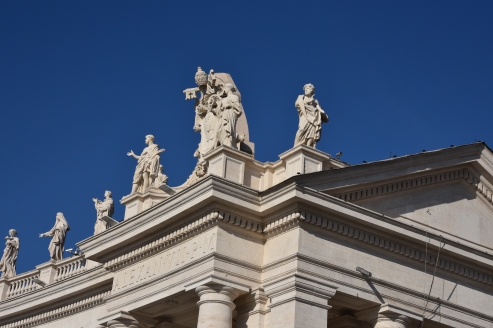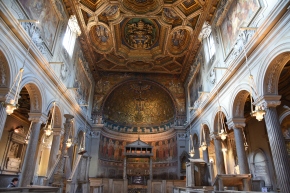What a stunningly brilliant edifice.
February 2017
Our Group
Pietá
St Peters
Churches
I had the opportunity to visit Rome from January 30 to February 3, 2017 with a class led by Dt. José Ángel Agejas, who earned his PhD at the Pontifical Gregorian University in Rome. (I’m keeping these pictures from Rome in my Spain category; they were taken on a trip organized by Francisco de Vitoria in Spain.)
The first church we visited was Santa Maria in Vallicella. “St. Gregory the Great built the first church on the site. By the 12th century, it was dedicated to Santa Maria in Vallicella (“Our Lady in the Little Valley”).
We then went to the church of Santa Pudenziana, which may be the oldest place of Christian worship in Rome. It was built over a 2nd-century house, probably during the pontificate of Pius I in 140–155 AD, and re-uses part of a bath facility still visible in the structure of the apse. This church was the residence of the Pope until, in 313, Emperor Constantine I offered the Lateran Palace in its stead. In the 4th century, during the pontificate of Pope Siricius, the building was transformed into a three-naved church. In the acts of the synod of 499, the church bears the titulus Pudentis, indicating that the administration of the sacraments was allowed.
San Pietro in Vincoli is not very imposing on the outside. But it is where Michaelangelo’s Moses is held.
The Basilica di San Bartolomeo all’Isola was built in the tenth century over the Roman Temple of Aesculapius. It is said to hold the remains of Saint Bartholomew. It also holds relics of many martyrs from the 20th and 21st centuries, such as the Bible read by Archbishop Romero of El Salvador when he was killed in 1980; a relic of Father Jacques Hamel, who was killed at a church in Normandy, France in July of 2016.
Basilica di Santa Prassede all’Esquillino was commissioned by Pope Hadrian I around the year 780, and built on top of the remains of a 5th-century structure and was designed to house the bones of Saint Prassede and Saint Pudenziana, the daughters of Saint Pudens, traditionally St. Peter’s first Christian convert in Rome. The two women were murdered for providing Christian burial for early martyrs in defiance of Roman law. The basilica is well known for its mosaics.
The Pontifico Istituto Orientale; Centro Studi e Ricerche Ezio Aletti is a workshop where contemporary mosaics are made. It is planning to produce a new chapel at the Universidad Francisco de Vitoria.

Chiesa Di Sant Ignazio di Loyola in Campo Marzio is a Counter Reformation style that exuberantly displays angels, saints, and all kinds of mystical beings. It is also the resting place for the Saint’s bones.
Contarelli Chapel holds three paintings on Saint Matthew by the Baroque painter Caravaggio.
San Pietro in Montorio was built on the site of an earlier 9th-century church dedicated to Saint Peter on Rome’s Janiculum hill. According to tradition, it was the site of his crucifixion. The Tempietto (“small temple”) is a small commemorative tomb built by Donato Bramante, in about 1502. It is meant to mark the traditional exact spot of St. Peter’s martyrdom, and is a precursor to Bramante’s rebuilding of St. Peter’s. It influenced the building of many other domes, including that over the US Congress.
Basilica Di San Clemente al Laterano is dedicated to Pope Clement I. There is: (1) the present basilica built just before the year 1100; (2) beneath the present basilica is a 4th-century basilica that had been converted out of the home of a Roman nobleman, part of which had in the 1st century briefly served as an early church, and the basement of which had in the 2nd century briefly served as a mithraeum (a temple dedicated to the Roman God Mithras); (3) the home of the Roman nobleman had been built on the foundations of republican era villa and warehouse that had been destroyed in the Great Fire of 64 AD.














































































































Recent Comments